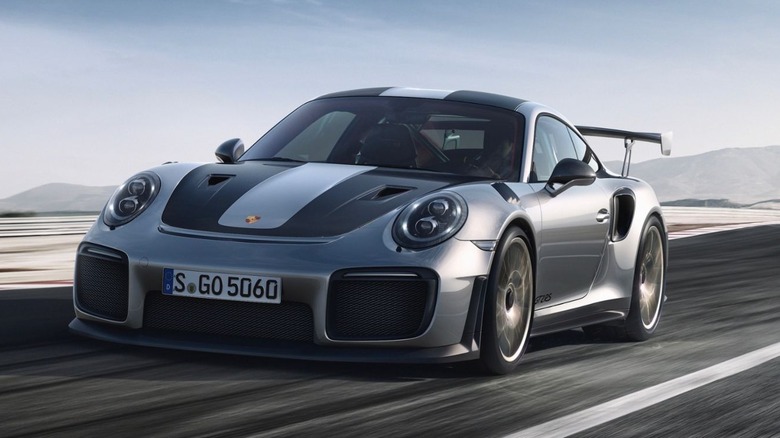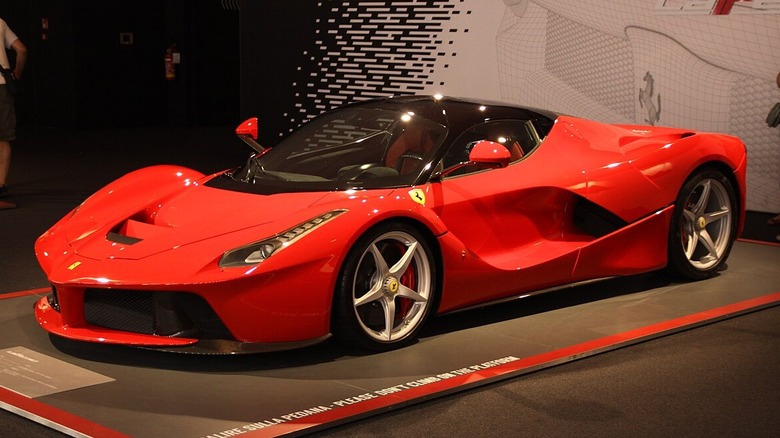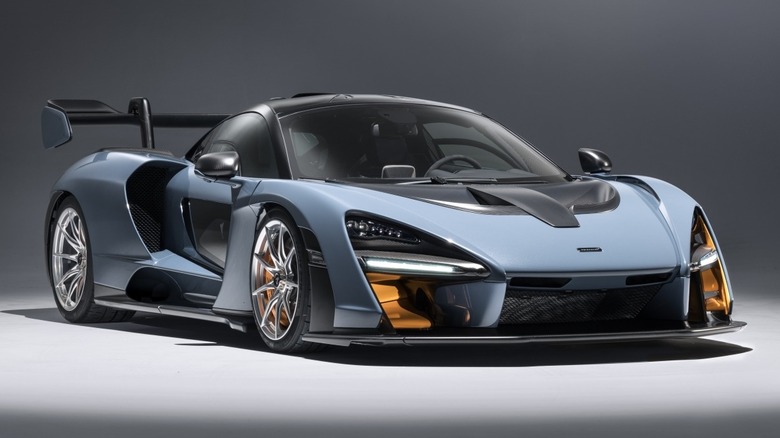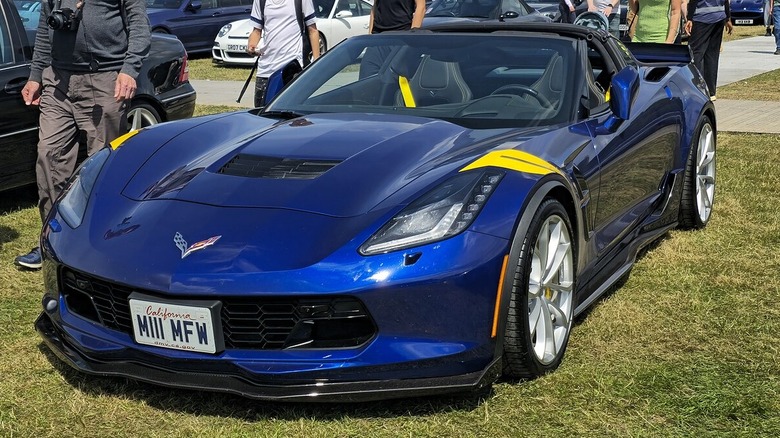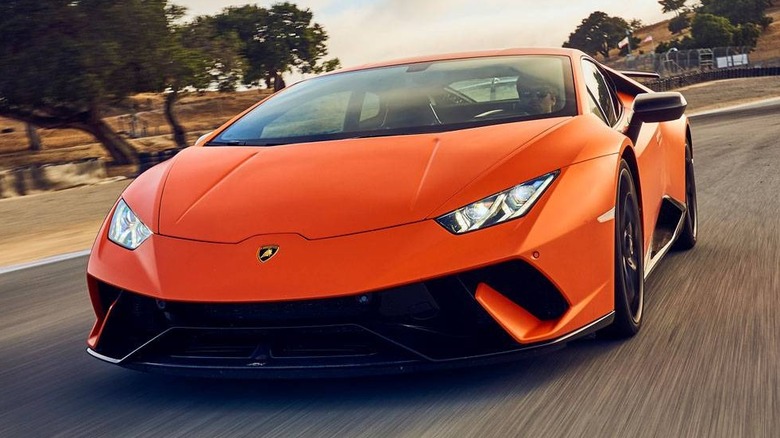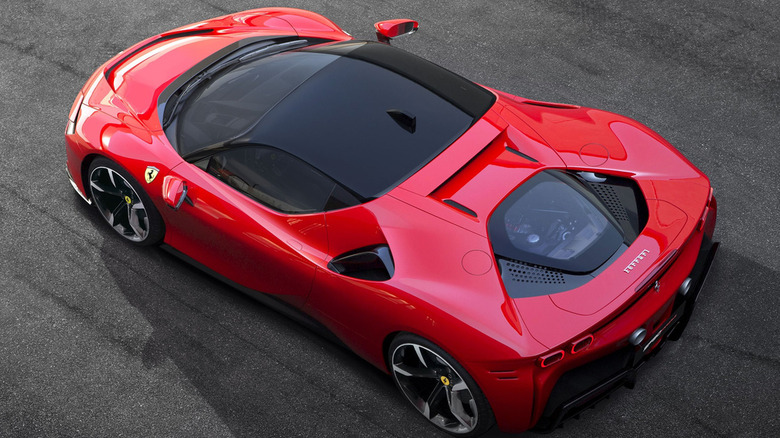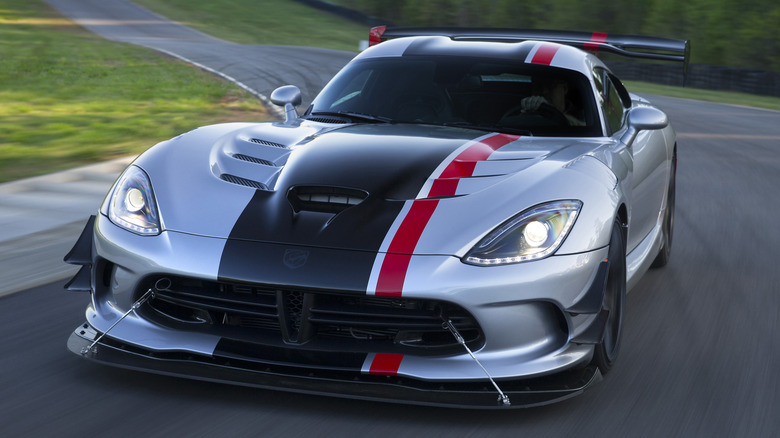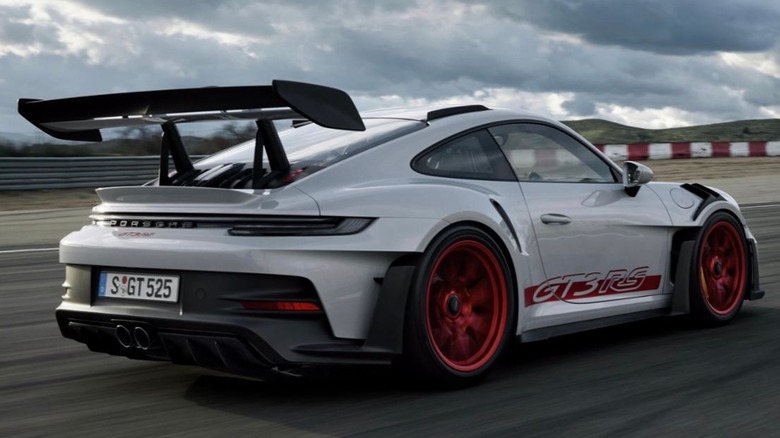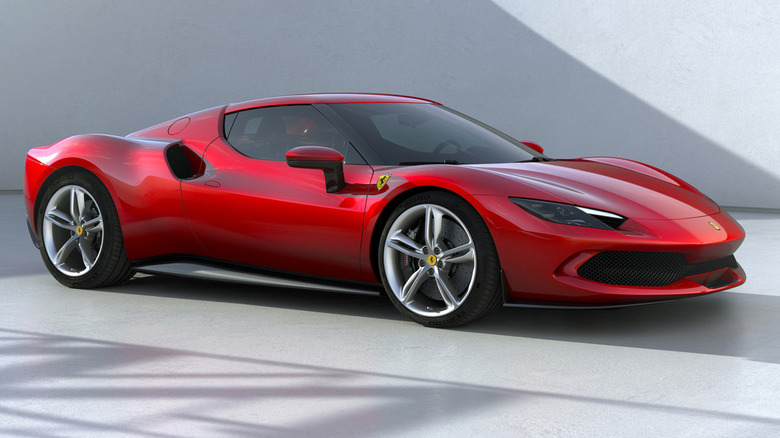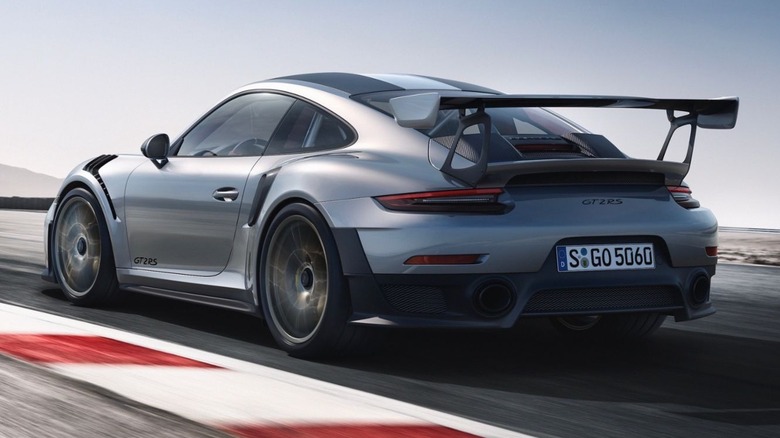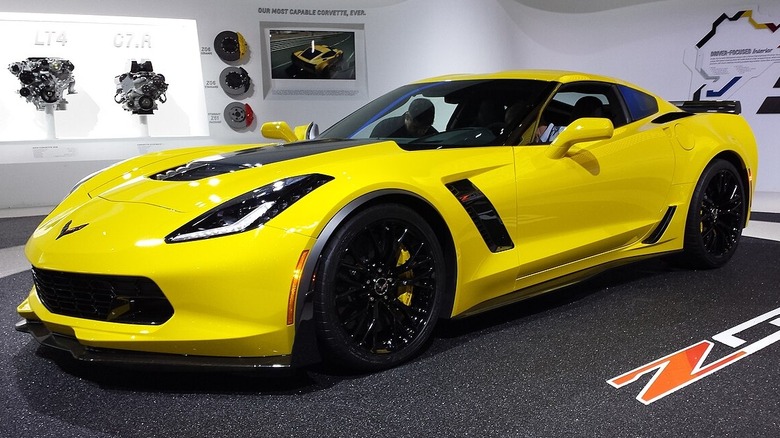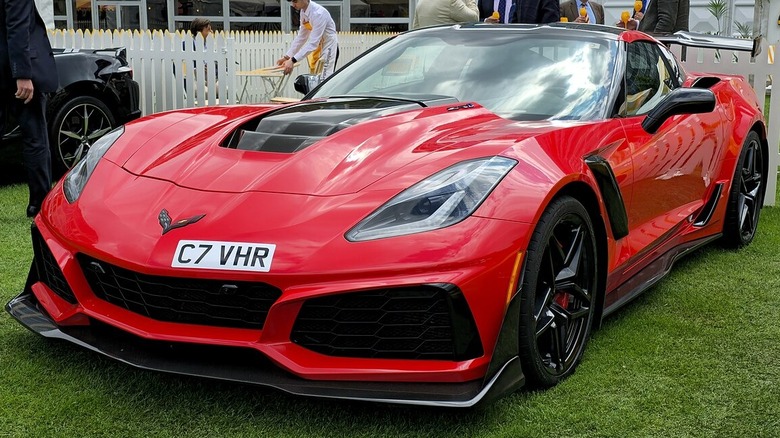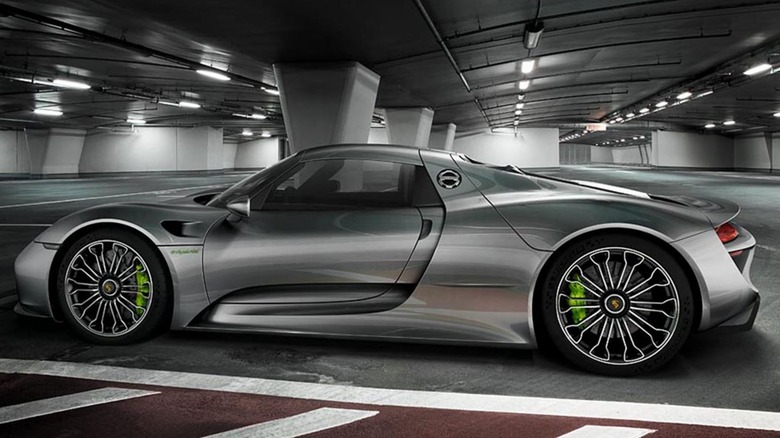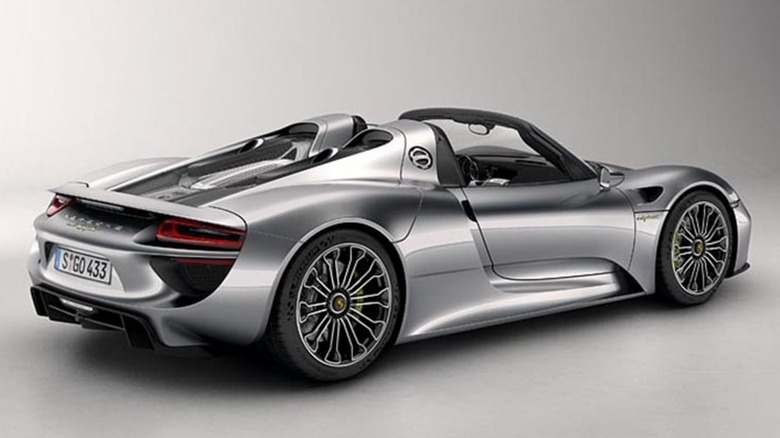13 Cars With The Best Braking Systems, Ranked By Stopping Distance
Discussions around the latest high-performance car, be it of the electric, pony, sports, super, or hyper variety, tend to focus on the 0 to 60 mph time. Lately, this all-important metric has seen values specified with hundredths, as being 0.01 second faster to 60 mph from a standstill remains a critical aspect of boasting. What sees less conversation is stopping distance, and considering the ease with which modern performance vehicles reach triple-digit speeds, this should be a more important consideration.
To encourage debate on this subject, we've put together this list of cars with the best braking systems, ranked by stopping distance. Specifically, how many feet it takes to go from 70 to 0 mph. As you might expect, the front-runners are largely high-dollar exotics with pizza-sized brake rotors constructed from equally exotic carbon ceramic material. But there are a few surprises thrown in there from cars that illustrate their staggering value proposition in the form of serious stopping power.
As a reference point, the car with the longest stopping distance on this list uses regular cast-iron brake rotors to achieve a distance of 142 feet. Just over 20 years ago, the Ferrari Enzo, an early adopter of carbon ceramic brakes, did the deed in 151 feet. In other words, braking systems have come a very long way, and the following are the best.
2024 Ford Mustang Dark Horse: 142 Feet
The Mustang Dark Horse is plenty fast, hitting 60 in 4.1 seconds and the quarter-mile in 12.5 seconds at 115 mph. Successor to the Mach 1 and Shelby GT350, the Dark Horse is packing a naturally aspirated 5.0-liter V8 making 500 horsepower at 7,250 rpm. Equally impressive to this range-topping Mustang's speed and power is its stopping distance of 142 feet from 70 mph. Much of that is due to the huge 15.4-inch front brake rotors clamped by 6-piston Brembo calipers. The discs out back measure 14 inches even and have 4-piston calipers mounted on them.
Other notable features related to the Dark Horse's stopping distance are the brake-by-wire system it employs and the Pirelli P Zero Trofeo RS rubber enabling a wide, sticky contact patch. These tires are an evolution of the tires found on the McLaren Senna, which costs nearly a million dollars by the way, and measure 315 mm wide out back. Not only does all this performance come at less than one-tenth the cost of a Senna, the Mustang Dark Horse's 60-0 mph stopping distance of 90 feet is two feet shorter than what the million-dollar McLaren could manage.
2015 Ferrari LaFerrari: 136 Feet
Tying the McLaren Senna in the 70-0 mph braking test, Ferrari's LaFerrari is edged out by the McLaren, by just 3 feet, with a 60-0 mph stopping distance of 95 feet. The most powerful production Ferrari at the time, this successor to the Enzo featured the first hybrid powertrain in the Italian automaker's history. Blending a naturally aspirated 6.3-liter V12 with a battery-powered electric motor, the LaFerrari made a combined 950 hp at a heady 9,000 rpm. One of the fastest Ferraris by top speed, measuring 218 mph, the LaFerrari also came with carbon-ceramic brakes measuring 15.7 inches in the front and 15.0 inches in the rear.
Pirelli P Zero Corsa tires, developed specifically for this car, delivered a relatively huge contact patch, measuring 345 mm in width at the rear. That translates to 13.5 inches and achieved stable, reliable stoppages. Special touches included a hand-laid carbon fiber monocoque, while performance highlights ranged from a 2.5-second 0-60 time, 100 mph in less than five seconds, and a 9.8-second quarter-mile run at 150 mph. Not bad for a car with a base price of $1,420,000.
2019 McLaren Senna: 136 Feet
As mentioned, the McLaren Senna was expensive, with as-tested prices running up to about $965,000. Considered one of the best McLarens of all time, the Senna was a barely street-legal race car. Spec highlights include a 4.0-liter twin-turbo V8 rated for 789 hp and 590 lb-ft of torque. At wide-open throttle, it registered 102 decibels of shrieking glory. Skidpad grip came in at 1.12 g, 60 mph came in 2.8 seconds, and the Senna was good for a top speed of 208 mph. It's the kind of car you really want to know can stop when the time comes, and on that front, the British automaker succeeded.
Measuring 15.4 inches all-around, the cross-drilled carbon ceramic brake rotors on the Senna were made from a material that, at the time, straddled the line between high-performance street car and actual race car equipment. McLaren said the Senna's brakes took seven times longer to create than the versions found on the 720S, and under braking from speeds beyond 70 mph, longitudinal force measured more than 1.5 g. Depending on the source, that translates to a stopping distance of as much as 136 feet or as little as 123 feet from 70 mph.
2017 Chevrolet Corvette Grand Sport: 136 Feet
Though the 2017 Corvette Grand Sport has the same 70-0 stopping distance as the Senna and LaFerrari, it outbrakes both of those hypercars from 60 mph to a standstill with a distance of 90 feet. And though it is unrelated to stopping distance, note that this particular Corvette came with a $75,000 as-tested price. Little wonder America's Sports Car enjoys a reputation as a remarkable value in the arena of world-class performance. Slotted below the period Corvette Z06 and ZR1, the Grand Sport was still potent with a 460-horse 6.2-liter V8 and all the best Z06 go-fast components.
But for maximum performance, look to the Z07 package with carbon-ceramic brakes, an upgraded suspension, and Michelin Pilot Super Sport rubber measuring 285/30 up front and 335/25 out back. Unlike many of the vehicles here, these Corvettes offered a manual transmission and with it, the ability to go from 0 to 60 in 3.9 seconds on to a top speed of 175 mph, all while pulling as much as 1.13 g in hard cornering. Magnetic Ride Control was just one more performance feather in the cap of this value-packed version of the long-running Corvette.
2018 Lamborghini Huracán Performante: 135 Feet
During our drive of the Huracán Performante, it was clear this Lambo was made for dominating the corners. With a carbon-ceramic braking system, it was equally clear the Performante had skills in the stopping distance department. Known for delivering hot lap after hot lap without brake fade and a consistently hard brake pedal with linear response, this hardcore variant of the Huracán was designed for the track. To that end, the Italian automaker fitted it with a trick active aero system, dubbed Aerodinamica Lamborghini Attiva, that could adjust the flow of air over the front end and via valves within the rear spoiler.
Magnetorheological dampers and all-wheel drive offered sharp handling to the tune of 1.11 g on the skidpad, while the 40-valve, naturally aspirated V10 delivered 631 hp at 8,000 rpm. Dripping with staggering performance metrics, highlights of the 2018 Huracán Performante include 0-60 in 2.2 seconds, 0-180 in 23.2 seconds, and a 202-mph top speed. The eye-watering $300,000-plus price tag was somewhat justified by tasty bits like single-piece carbon fiber racing shells, a 29-hp increase over the standard Huracán, and Pirelli P Zero Trofeo R tires.
2021 Ferrari SF90 Stradale: 134 Feet
One of the fastest accelerating cars on the planet, the Ferrari SF90 Stradale can hit 60 in two seconds flat and clear the quarter-mile in 9.5 seconds at 148 mph. To do so, Ferrari started with a 4.0-liter twin-turbo V8 making 769 hp, then added a plug-in hybrid system consisting of dual 133-hp electric motors on the front axles and a single 201-hp motor sandwiched between the V8 and the 8-speed dual-clutch transaxle. Combined output for this AWD hypercar measured 986 hp and 590 lb-ft of torque.
Along with the impressive powertrain came Ferrari's first use of a brake-by-wire system featuring 15.7-inch front and 14.2-inch rear cross-drilled carbon-ceramic rotors. It left critics impressed. Motor Trend wrote, "Ferrari's first-ever brake-by-wire system sets massive carbon-ceramic discs, huge brake calipers, and the regenerative capability of the front motors to the task of hauling the car down to a stop ... with incredible force" Considering the $513,000 base price and potential for a $742,000 sticker with options, it's good to know that this successor to the LaFerrari halo car lives up to the reputation.
2016 Dodge Viper ACR: 134 Feet
If the Ferrari SF90 Stradale is all about exotic automotive finesse, the Dodge Viper ACR is simply a brute, but in all the best ways. Featuring an enormous 8.4-liter naturally aspirated V10 nestled within an incredibly long snout, the Viper is a sledgehammer to the SF90's scalpel. And yet, it matches it in stopping distance from 70 mph and bests the Ferrari by 12 inches from 60 mph. To do so, Dodge fitted these Vipers with carbon-ceramic brakes, size huge, clamped by six-piston front and four-piston rear calipers.
The aero package on these models, which included a front splitter, dive planes, ventilated front fenders, a scary-looking rear diffuser, and an outrageous adjustable rear wing, did little to help the Viper ACR stop faster, but it did enable 2,000 pounds of downforce at high speed. Notably, the front splitter was designed for ease of replacement. Good thing, as the car's braking power was so wicked that this front-end addendum would plow into the pavement under hard stops. Making 645 horsepower, sporting a pair of side-exit exhausts, and capable of gripping with 1.15 g of lateral force, the Viper ACR remains one of the wilder factory hot rods with incredible stopping power.
2023 Porsche 911 GT3 RS: 133 Feet
RS stands for Renn Sport in Porsche-speak and is reserved for the German automaker's most dynamically capable cars. In the case of the 2023 911 GT3 RS, that means a naturally aspirated 4.0-liter flat-6 making 518 horsepower at 8,500 rpm, 342 lb-ft of torque, a 2.8-second sprint to 60, and pulling 1.18 g around the skidpad. With great power comes great stopping distance, hopefully, which measures 133 feet from 70 mph in the GT3 RS. Helping with this are the 16.1-inch front and 15.0-inch rear drilled carbon-ceramic brake rotors.
The Michelin Pilot Sport Cup 2 R tires with 275 front and 335 rear section widths are helpful too. Opt for the $33,000 Weissach package and you can boast about the forged magnesium staggered wheels on top of all this. The carbon fiber heavy GT3 RS shares not a single body panel with its more "pedestrian" 911 Carrera stablemate, and according to Motor Trend, "...most drivers will need to raise their game substantially and readjust their perceptions of what's possible on the brakes." The same could be said of the driver's finances, as the 2023 GT3 RS comes with a price tag up to $302,000.
2023 Ferrari 296 GTB: 130 Feet
In some circles, the idea of spending more than $500,000 would be absurd and in the circles where folks are actually doing so, the idea of a Ferrari with a V6 engine might be met with the same reaction. However, the Ferrari 296 GTB is an example of a high-performance car that proves downsizing isn't so bad. These Italian stallions have historically been associated with V8 and V12 engines. So the 3.0-liter V6 in the 296 GTB may sound odd, except for the fact that it comes strapped with a pair of turbos, has a 120-degree bank angle to give it the firing cadence of a V12, and makes 818 hp in conjunction with a plug-in hybrid system.
That results in world-beating performance metrics like 0-60 in 2.3 seconds and 0-150 in under 10 seconds. The 296 GTB also has a beast of a braking system, cutting it down from 60 in just 88 feet and 70 in 130 feet. Featuring a brake-by-wire setup, big carbon-ceramic rotors, and Michelin Cup 2 R rubber, the 296 GTB is known for confidence-inspiring braking with no lack of linearity in its high-tech system.
2018 Porsche 911 GT2 RS Weissach Edition: 129 Feet
The Porsche 911 GT2 RS is the Mr. Hyde to its Dr. Jekyll GT3 RS brother. Both are impressive in their own right, but the GT2 variant could be considered downright scary thanks to a bonkers twin-turbo flat-6 engine making 700 hp and 553 lb-ft of torque. Designed for all-out track dominance, the GT2 RS is what happens when Porsche lets its RS engineers off the leash. It comes with an adjustable ball-jointed suspension, a top speed limited to 211 mph in order to preserve the Dunlop Maxx Race Tires, and a distilled water spray system to cool the intake charge.
As per the norm in this crowd, the 911 GT2 RS has cross-drilled carbon-ceramic brakes that measure 16.1 inches in the front and 15.4 out back. You can trim 40 pounds of curb weight with the optional $31,000 Weissach package that features carbon fiber anti-roll bars and end links, among other things. But even without it, Porsche's track weapon will hit 60 mph from a standstill in 2.6 seconds and clear the quarter in 10.3 seconds at 139 mph. It can then arrest that speed with one of the shortest stopping distances of any car.
2015 Chevrolet Corvette Z06: 128 Feet
The top three cars with the shortest stopping distance from 70 mph are all within a 4-foot span. That may seem like splitting hairs, but compared to how deep critics get into the weeds on 0-60 times, this is to be expected. What some may not expect is that the Chevrolet Corvette takes second and third on this podium of stopping power. First up is the 10-year-old Corvette Z06 with the Z07 package. Already a world-class supercar with its supercharged 6.2-liter V8 making 650 hp and 650 lb-ft of torque, the Z07 bundle added the all-important carbon-ceramic brake rotors.
The 15.6-inch front units were larger in diameter by a full inch over the base Z06, though the Brembo 6-piston front and 4-piston rear brake calipers carry over. Dispatching 60 mph in three seconds flat, the 2015 Z06 also set production-car records, at the time, of 1.19 g in lateral grip and a 128-foot stopping distance from 70 mph. When you consider the Z06 beats million-dollar hypercars, the sub-$100,000 price point on these C7 Corvettes seems downright reasonable.
2019 Chevrolet Corvette ZR1: 127 Feet
When the Corvette ZR1 arrived for 2019, it would become the most powerful front-engine Vette of all time. The supercharged 6.2-liter pushrod V8 made 755 hp and 715 lb-ft of torque that was routed to the rear wheels via an 8-speed automatic and an electronically-controlled limited-slip differential. Unlike the current Corvette generation, this ZR1 could even be had with a manual transmission. Michelin Pilot Sport Cup 2 R rubber put the power to the road, enabling the ZR1 to hit 60 in 3.0 seconds and 150 in 13.7 seconds. 212 mph was the top speed, so the C7 ZR1 required serious stopping power.
Chevy provided it with 15.5-inch front and 15.3-inch rear carbon-ceramic units that, per period tests, were unfazed under braking from 183 mph. Adding the ZTK Track Performance package brought a bevy of aerodynamic doodadery and a flat undercarriage, which combined with an enormous rear spoiler to give the ZR1 big-time presence. As equipped, however, the sticker came in at "only" $143,810, which is $704,165 less than the car with the 70-0 mph stopping distance record, by just three feet.
2015 Porsche 918 Spyder: 124 Feet
The 2015 Porsche 918 Spyder owns the current title for shortest stopping distance from 70 mph, with a length of 124 feet. While doing so, it delivers 1.15 g of force on the driver, a figure that jumps to 1.24 under hard acceleration. 0 to 60 comes in 2.2 seconds, and in another 7.6 seconds, you've cleared the quarter mile and are going 145 mph. The 918 Spyder's top speed is 214 mph.
These are big numbers, even in this company, and the mighty Porsche manages it all with an 887-hp hybrid powertrain derived from the automaker's Le Mans racing program and featuring an ICE with a specific output of 132 hp/liter. The front carbon-ceramic rotors measure 16.1 inches in diameter, the entire chassis and body are made from carbon fiber, and it has an active front spoiler. All of which adds up to a curb weight of 3,791 pounds, kind of porky compared to its competitors. And yet, the Porsche 918 Spyder is an absolutely incredible performer in both speed and stopping distance.
Methodology
To compile this list of cars with the best braking systems, we gathered data on 70-0 mph stopping distance from Car and Driver and Autocar, then ordered them from longest to shortest distance. Any cars with matching distances were then ranked according to 60-0 mph stopping distance data sourced from Motor Trend.
